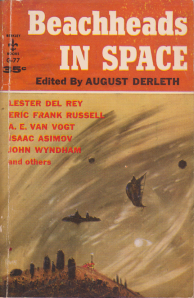The Book: Cosmic Engineers by Clifford D. Simak. Originally published in 1950 as a novel (based on a serial in Astounding published in 1939), the edition read was published by Paperback Library (52-498) and printed in 1967.

The Setting: Space, Pluto, and a planet at the far end of the Universe. The year: 6948.
The Story: Oh good golly, where to begin. Two newspaper men, somewhere near Pluto, find a thousand year old prison ship and a lovely young scientist in suspended animation within it. They wake her and learn that her lovely smart brain has been working for those thousand years and is now way beyond most normal human brains. Just then! A call from Pluto where scientists have intercepted signals from across the universe – thought signals! And the young woman, Caroline Martin, is able to communicate with the advanced brains! These advanced creatures, the Cosmic Engineers, need help. So the humans build a stargate and get to the Engineers to learn that our Universe will collide with a different Universe, destroying both. As they try to work out what to do, they come under attack from the Hellhounds, a hateful race that would just as soon have the Universe end. The humans have to travel forward in time to a distant future earth to get some science answers, which they do, but are sidetracked on their way back by an insane, omnipotent intelligence. Then they get back, defeat the Hellhounds, and save the Universe. Phew.
The Science: The science in this book all seemed pretty sketchy as presented. The idea of multiple universes is something that physicists are pretty cool with, but have no way of proving, since, of course, they are not within our universe. So that’s something. But I’m afraid that’s all I feel like talking about.
The Reaction: At first, I was really excited about this book. Oh! Another smart female scientist! How lucky! But then the book became one insane incident after another. I was forced to step back and realize what a mess this book was. There was too much story and not enough craft. The front cover has a quote “…enough thrills for five sequels.” Enough thrills for five separate short novels, more like. It was like a series of unfortunate Star Trek episodes, but without the characters.
The Cover: The cover is a definite high point. There’s a metal man with a ray gun, rocket ships, and people in space suits. It’s pretty awesome. That metal man? That’s a Cosmic Engineer, depicted quite nicely.
Next Up: NSF: “The Great Fire” by Ray Bradbury




